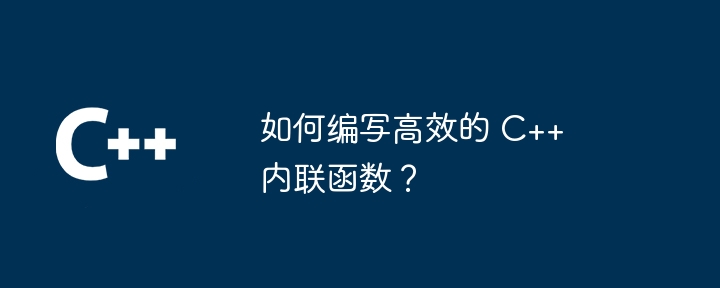Home >Backend Development >C++ >How to write efficient C++ inline functions?
How to write efficient C++ inline functions?
- WBOYWBOYWBOYWBOYWBOYWBOYWBOYWBOYWBOYWBOYWBOYWBOYWBOriginal
- 2024-04-16 13:33:02814browse
Inline functions improve the performance of small functions by inserting the function body directly into the call site. Key steps include: Declare inline functions using the inline keyword. Good for small functions (usually less than 5-10 lines of code) to avoid function call overhead. Be cautious about inlining large functions as it increases code size and compilation time. Note the visibility restrictions on mutable objects in inline functions.

How to write efficient C inline functions
Introduction
Inline Functions are a C feature that inserts the body of a function directly into the call site during compilation, which can significantly improve the performance of small functions. Inline functions optimize code execution speed by reducing function call overhead.
Syntax
##inline Keywords are used to declare inline functions:
inline 返回值类型 函数名(参数列表) {
// 函数体
}
Use actual cases
Consider a function that calculates the sum of two numbers:// 非内联版本
int add(int a, int b) {
return a + b;
} We can rewrite this function inline: inline int add(int a, int b) {
return a + b;
}
Performance advantages
When calling a non-inlineadd() function, the compiler will generate the following assembly code:
call addThis will generate a function call overhead, including pushing parameters on the stack , jump to the function address, execute the function body and return to the calling location. For inline
add() functions, the compiler will insert the function body directly into the call site:
add eax, ebxThis eliminates function call overhead, thereby improving performance.
Best Practices
- Make small functions inline: Inline for small functions (usually less than 5-10 lines of code) is very efficient because its overhead is much less than the overhead of a function call.
- Avoid inlining large functions: Inlining large functions increases code size and may result in longer compilation times.
- Use mutable with caution: After modifying the mutable object in an inline function, you should pay attention to its visibility restrictions.
Conclusion
Inline functions are a powerful C feature that can be used to improve the performance of small functions. By understanding its syntax, using best practices, and applying inlining in real-world use cases, you can significantly improve the efficiency of your code.The above is the detailed content of How to write efficient C++ inline functions?. For more information, please follow other related articles on the PHP Chinese website!

